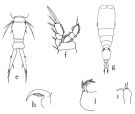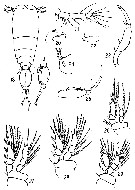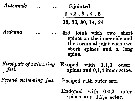|
|
 |
|
Cyclopoida ( Order ) |
|
|
|
Sapphirinidae ( Family ) |
|
|
|
Vettoria ( Genus ) |
|
|
| |
Vettoria parva (Farran, 1936) (F,M) | |
| | | | | | | Syn.: | Corissa parva Farran, 1936 a (p.132, Descr.F, figs.F); Johnson, 1942 b (p.436, figs.M); Sewell, 1948 (p.420); Krishnaswamy, 1952 (p.326, Rem.); Shmeleva, 1964 a (p.1068); Pavlova, 1966 (p.45); Saraswathy, 1966 (1967) (p.102); Owre & Foyo, 1967 (p.112, figs.F,M, Rem.); Scotto di Carlo,1967 (p.239, Descr.M, figs.M); De Decker, 1984 (p.317) | | | | Ref.: | | | Hure & Scotto di Carlo, 1967 (p.292, 295, figs.F,M); Bourcier & al., 1969 (p.272, 273); Chahsavar-Archad & Razouls, 1982 (p.32, fig.M); Boxshall & Halsey, 2004 (p.653); Avancini & al., 2006 (p.141, Pl. 109, figs.F,M, Rem.); Vives & Shmeleva, 2010 (p.395, figs.F,M, Rem.) |  issued from : J. Hure & B. Scotto di Carlo in Pubbl. Staz. zool. Napoli, 1967, 35. [p.293, Pl.IV]. Female: d, habitus (dorsal). Nota: Proportional lengths of urosomites and furca 36:7:14:43 = 100.
|
 issued from : J. Hure & B. Scotto di Carlo in Pubbl. Staz. zool. Napoli, 1967, 35. [p.293, Pl.IV]. Female: e, urosome (dorsal); f, P1. Nota: P5 with 3 spines. Mx2 slightly differs from Farran (1936). Male: g, habitus (dorsal); h, Md; i, Mx1; j, Mx2. Nota: Proportional lengths of urosomites and furca 52:3:12:33 = 100.
|
 Issued from : G.P. Farran in Great Barrier Reef Expedition 1928-1929, Scient. Rep., V, N°3, 1936. [p.133, Fig.27]. As Corissa parva. Female: a, habitus (dorsal); b, idem (lateral right side); c, urosome (dorsal); d, A1; e, A2; f, Md and Mx1; g, Mx2; h, Mxp; i, P1; j, P2; k, P3; l, P4. Nota: The proportional length of the abdominal segments and furca 25:5:8:28. A1 5-segmented, segmentation between 4th and 5th segments imperfect. Cephalon with a small lateral lenticular swelling near its posterior margin on either side and two contiguaous lenses occupying the whole frontal width.
|
 issued from : B. Scotto di Carlo in Pubbl. Staz. zool. Napoli, 1967, 35. [p.240, Fig.1]. As Corissa parva. Male (from Gulf of Naples): a, habitus (dorsal); b, idem (lateral left side); c, urosome; d, A1; e, A2; f, Md; g, Mx1; h, Mx2; i, Mxp; j, P1; k, P4. Nota: abdominal segments 3-segmented. Abdominal segments and caudal rami in the proportion 52:3:12:33. A1 5-segmented, proportional length of segments 15:27:24:15:19. Mx, as in the female, with massive palp followed by a robust hook and two strong spines having setae on its outer edge. All the swimming feet are the same as those of the female, except P1 which shows on the endopodite of the 3rd segment a spine of irregular form, very strong, narrowing at the end to form a kind of hook, and having on the inner edge a row of thin setae.
|
 issued from : M.W. Johnson in Trans. Am. microsc. Soc., 1942, 61. [p.435, Pl.III]. As Corissa parva. Male (from 27°50'N-26°13'N, 135°25' W-142°02'W): 18, habitus (dorsal); 19, urosome (lateral); 20, Md (enlarged scale); 21, A1; 22, Mx1 (enlarged scale); 23, A2; 24, Mx2 (enlagged scale); 25, Mxp; 26, P4; 27, P3; 28, P2; 29, P1.
|
 Issued from : S. Krishnaswamy in Rec. Indian Mus., 1952, 49 (3-4). [p.326]. As Corissa parva. Distinctive morphometric characters. Compare with Vettoria indica.
| | | | | Compl. Ref.: | | | Deevey, 1971 (p.225); Apostolopoulou, 1972 (p.329, 380); Deevey & Brooks, 1977 (p.156, tab.2, Station "S"); Kovalev & Shmeleva, 1982 (p.86); Scotto di Carlo & al., 1984 (p.1043); Böttger-Schnack, 1995 (p.93); 1997 (p.409); Hure & Krsinic, 1998 (p.89, 105); Siokou-Frangou, 1999 (p.479); Vukanic, 2003 (p.139, tab.1); Mazzocchi & Di Capua, 2010 (p.429); Uysal & Shmeleva, 2012 (p.909, Table I); Belmonte & al., 2013 (p.222, Table 2, abundance vs stations); Benedetti & al., 2016 (p.159, Table I, fig.1, functional characters) | | | | NZ: | 7 | | |
|
Distribution map of Vettoria parva by geographical zones
|
| | | | | | | | | | Loc: | | | South Africa (E), off S Cape Verde Is., Florida, Sargasseo Sea, off Bermuda (Station "S"), Medit (Alboran Sea, NW Basin, Ligurian Sea, G. of Napoli, Gulf of Taranto, S & N Adriatic Sea, Aegean Sea, Lebanon Basin), Red Sea, Australia (Great Barrier), off E Hawaii | | | | N: | 25 | | | | Lg.: | | | (34) F: 0,87; (140) F: 0,901-0,799; M: 0,867-0,799; (530) F: 0,9; M: 0,8; (707) M: 0,88-1,0; (709) F: 0,93-0,87; M: 0,92-0,85; (710) F: 0,93-0,87; M: 0,92-0,85; {F: 0,799-0,930; M: 0,8-1,0} | | | | Rem.: | epi-mesopelagic. (100-300 m, sometimes ?1000 m in the Gulf of Naples). Overall Depth Range in Sargasso Sea: 0-500 m (Deevey & Brooks, 1977 (p.156, tab.2, Station "S"); | | | Last update : 03/12/2020 | |
|
|
 Any use of this site for a publication will be mentioned with the following reference : Any use of this site for a publication will be mentioned with the following reference :
Razouls C., Desreumaux N., Kouwenberg J. and de Bovée F., 2005-2025. - Biodiversity of Marine Planktonic Copepods (morphology, geographical distribution and biological data). Sorbonne University, CNRS. Available at http://copepodes.obs-banyuls.fr/en [Accessed October 19, 2025] © copyright 2005-2025 Sorbonne University, CNRS
|
|
 |
 |









